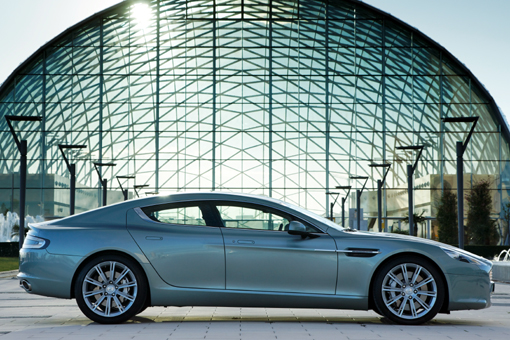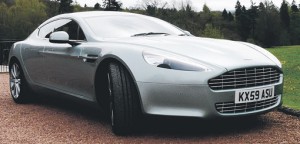Aston Martin Rapide
Famed for its sports coupes and grand tourers, Aston Martin has produced its first four-door sports saloon. Frederic Manby checks it out.
EDDLESTON, south of Edinburgh. The Barony Castle Hotel is waking to another day in the Scottish Borders.
It is home to Scotland’s paramedic training school and, for a few days this week, a launch location for Aston Martin’s first four-door sports saloon, the fabulous Rapide.
The porridge was excellent, too, once I found a way through the labyrinth of stairs and passages from the hotel’s nether regions.
In contrast, the Rapide was most accessible. You can ignore its 470 horse power and tootle along the quiet roads. The automatic gearbox is subliminal.
The biggish car is surprisingly easy to position and judge on the narrow sections, though at two tons it lacks the weft and weave of the shorter, lighter DB9 Coupé, with which it shares mechanical components and some underpinnings.
The DB9 is a 2+2, which means there is not much space in the rear seats. The Rapide has four doors and four proper seats, split back and front by an elbow-high console which runs from the dashboard.
The Rapide is actually ahatchback, with the convenience of a long tailgate. The luggage area is decent enough, carpeted of course, stepped to accommodate the 90-litre “saddle bag” fuel tank which runs across the back. The seats tumble forward when a button is pressed, extending the load area.
In the upright position,there is a shelf behind these seats for things you may need while on the move. You could even put a dog or two there, with the proviso that there are no anchorage points for pet restraints.
How roomy are the rear seats? Head space is good and I could sit comfortably behind my co-driver, Jack. We had an average height of six feet.
Back at the helm, then, the Rapide starts by pushing a glass-cased “key” into a slot.
Keyless start with a starter button is a better system, and the other immediate shock on a £140,000 car (or £139,950 as the PR assistant corrected) is the manual (and quite coarse) adjustment for the steering wheel position,rather than a power button.
This is a fine-looking car,emphasising the design trends started by Ian Callum before he moved over to Jaguar. The work has been enhanced by his successor, director of design, Marek Reichman. He led the inhouse design team which penned the Rapide and this is how he sums up the result.
“Like a race horse standing still, you can see its power and elegance, the shape of Rapide’s rear haunches are muscular, conveying the power that lies beneath while its low stance produces a powerful look.
“There is a real sense of proportion with this car, akin to a tailored suit; the new double grille gives more presence on the road while the iconic signature side strake has been lengthened through to the rear doors to enhance its lateral proportions in a subtle, yet elegant way. The car’s purity makes it look right from every angle,” says Marek, born in Sheffield and educated at Teesside University.
Rapide, by the way, is built by Steyr in Austria, an aspect which Aston Martin is keen not to hide. It becomes the first of the marque to be made outside England. The V12 engine is built by Ford in Cologne. Very little of the Rapide is shipped from Britain.
As such, it gives us the interest of an Austrian-built British thoroughbred with a German engine, pitched against a German car, the four-door Porsche Panamera.
I don’t think even the most ingrained member of the Porsche family dynasty would claim that the Panamera is better-looking than the Rapide. The former is imposing, handsome even. The latter is beautiful.
Here’s what another German says about it, Aston’s chief executive, Ulrich Bez: “Rapide is the culmination of the Aston Martin range of sports cars, a car that seals the revival of a truly admired marque. There is now an Aston Martin for every taste and for every use. With Rapide, the entire family can enjoy their Aston Martin together in unison, in an invigorating environment.”
I suppose Dr Bez has had time to understand and master the switchgear. As a “first timer”, I found some dilemmas.
The exterior is exquisite. The exterior panels are either steel or aluminium or synthetic, embellished with solid metals such as magnesium, aluminium or zinc. Inside, anything which looks like metal is metal, with plenty of leather and timber choices.
The strakes which run over the top of the dashboard reflect loudly in the windscreen, and there is further visual interference from the metal pods which are part of the hi-fi system.
This is a quick car and the best way to experience the sound of the V12 is as a bystander. This is a great noise. The roads around Peebles and Moffat were fit to test the higher end of the car’s ability. They were sufficiently “normal” to find that Aston Martin’s boffins have not managed to isolate bump-induced tremor in the front wheels in corners.
Big Jack and I drove it in a mildly brisk way, with a few pints of petrol to get past slow traffic. The trip computer recorded 15.6 miles a gallon. A very quiet run back improved to 17 miles a gallon.
• This report has appeared in the Yorkshire Post


